Sommarfin |
||||||||||||||||||||||||||||
 |
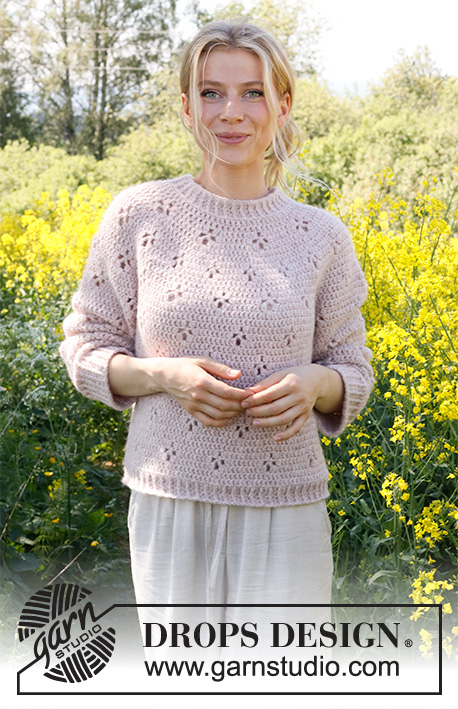 |
|||||||||||||||||||||||||||
Crocheted jumper in DROPS Air. The piece is worked top down, with round yoke and lace pattern. Sizes XS - XXL.
DROPS 232-49 |
||||||||||||||||||||||||||||
|
------------------------------------------------------- EXPLANATIONS FOR THE PATTERN: ------------------------------------------------------- PATTERN: See diagrams A.1 to A.8. INCREASE TIP: Increase 1 treble crochet by working 2 treble crochets in same stitch. CHAIN STITCHES: If you work outermost on the hook the chain stitch will often be too tight; 1 chain stitch should be as long as 1 treble crochet is wide. CROCHET INFORMATION: Each round of half-treble crochets begins with 2 chain stitches (these do not replace the first half-treble crochet) and finishes with 1 slip stitch in the 2nd chain stitch at the beginning of the round. Each round of treble crochets begins with 3 chain stitches (these do not replace the first treble crochet) and finishes with 1 slip stitch in the 3rd chain stitch at the beginning of the round. DECREASE TIP (sleeves): Work the first and last 2 treble crochets together as follows: * Make 1 yarn over, insert the hook through the next stitch, pick up the strand, 1 yarn over and pull the yarn over through the first 2 loops on the hook *, work from *-* 1 more time, make 1 yarn over and pull it through all 3 loops on the hook (= 1 stitch decreased), work as before until there are 2 stitches left, work 2 treble crochets together as described above. ------------------------------------------------------- START THE PIECE HERE: ------------------------------------------------------- JUMPER – SHORT OVERVIEW OF THE PIECE: The neck and yoke are worked in the round, top down. The yoke is divided for the body and sleeves and each piece is finished separately. NECK: Work 64-70-72-78-82-84 CHAIN STITCHES – read description above, with hook size 5 mm and DROPS Air. Form them into a ring with 1 slip stitch in the first chain stitch - read CROCHET INFORMATION. Work 1 half-treble crochet in each chain stitch = 64-70-72-78-82-84 stitches. Work A.1 over all stitches. When A.1 has been completed in height, the piece measures approx. 4 cm. Insert 1 marker at the beginning of the round; the yoke is measured from this marker! YOKE: Work 1 round with 1 treble crochet in each stitch and increase 0-2-8-10-14-20 treble crochets evenly spaced – read INCREASE TIP = 64-72-80-88-96-104 stitches. Work A.2 8-9-10-11-12-13 times on the round. REMEMBER THE CROCHET TENSION! When A.2 has been completed in height there are 128-144-160-176-192-208 stitches. The piece measures approx. 7 cm from the marker. Work 0-0-0-0-1-1 round with 1 treble crochet in each stitch. Work A.3 16-18-20-22-24-26 times on the round. Work 0-0-0-0-1-1 round with 1 treble crochet in each stitch. Work A.4 8-9-10-11-12-13 times on the round. When A.4 has been completed in height there are 176-198-220-242-264-286 stitches. Work 0-0-0-0-1-1 round with 1 treble crochet in each stitch. The piece measures approx. 19-19-19-19-22-22 cm from the marker. Work A.5 16-18-20-22-24-26 times on the round. Continue like this. AT THE SAME TIME when the piece measures 21-22-23-24-26-28 cm from the marker – adjust so the last round does not have 3 chain stitches/double crochets in the pattern, divide for the body and sleeves as follows: Work A.5 over 22-22-22-33-33-33 stitches, A.6 (adjust the pattern according to the round you start on), 1 treble crochet in each of the next 3-0-3-1-0-4 stitches, skip 34-40-45-49-51-54 stitches for the sleeve, work 11 chain stitches under the sleeve, 1 treble crochet in each of the next 3-0-3-1-0-4 stitches, A.5 over the next 44-55-55-66-77-77 stitches, A.6, 1 treble crochet in each of the next 3-0-3-1-0-4 stitches, skip 34-40-45-49-51-54 stitches for the sleeve, work 11 chain stitches under the sleeve, 1 treble crochet in each of the next 3-0-3-1-0-4 stitches, A.5 over the next 22-33-33-33-44-44 stitches. The body and sleeves are finished separately. BODY: = 130-140-152-166-184-200 stitches. Cut the strand. Start the round mid-under the right sleeve. Work 1 double crochet in the middle chain stitch, work 3 chain stitches, 1 treble crochet in each of the next 9-6-9-7-6-10 stitches (the first treble crochet is worked in the same chain stitch as the double crochet), A.5 over the next 44-55-55-66-77-77 stitches, A.6, 1 treble crochet in each of the next 17-11-17-13-11-19 stitches, A.5 over the next 44-55-55-66-77-77 stitches, A.6, 1 treble crochet in each of the last 8-5-8-6-5-9 stitches. Continue this pattern. On round 6 in A.5 work a bobble in the last treble crochet under the sleeve before A.5 so the first repeat of A.5 has a complete flower. When the piece measures 21-22-23-24-24-24 cm from the division (adjust so the pattern finishes neatly) work A.7 over all stitches. Repeat the last round in A.7 until the piece measures 25-26-27-28-28-28 cm from the division. Cut and fasten the strand. The piece measures approx. 50-52-54-56-58-60 cm from the shoulder down. SLEEVES: Now work the 34-40-45-49-51-54 skipped stitches on the one side: Work 1 double crochet in the 6th chain stitch under the sleeve, 3 chain stitches, 1 treble crochet in each of the next 3-6-3-5-6-2 chain stitches (the first treble crochet is worked in the same chain stitch as the double crochet), A.8 (adjust the pattern according to the round you start on), A.5 over the next 33-33-44-44-44-55 stitches, 1 treble crochet in each of the last 2-5-2-4-5-1 stitches = 45-51-56-60-62-65 stitches. On round 6 in A.5 do not work the last bobble in the last repeat; only work bobbles where there is room for a complete flower. Continue this pattern in the round until the sleeve measures 3 cm. Now decrease 2 stitches under the sleeve – read DECREASE TIP! Decrease like this every 10-6-4-2½-2½-2 cm a total of 3-5-7-9-9-10 times = 39-41-42-42-44-45 stitches. Continue the pattern where it fits in width; the other stitches are worked with treble crochets. When the sleeve measures 32-31-31-30-28-27 cm (adjust so the pattern finishes neatly) work A.7 over all stitches. AT THE SAME TIME, on the first round decrease 1-1-0-0-0-1 treble crochet by working 2 treble crochets together (this is done so the pattern fits around the sleeve) = 38-40-42-42-44-44 stitches. Repeat the last round in A.7 until the sleeve measures 40-39-39-38-36-35 cm. Cut and fasten the strand. Work the other sleeve in the same way. |
||||||||||||||||||||||||||||
Diagram explanations |
||||||||||||||||||||||||||||
|
||||||||||||||||||||||||||||
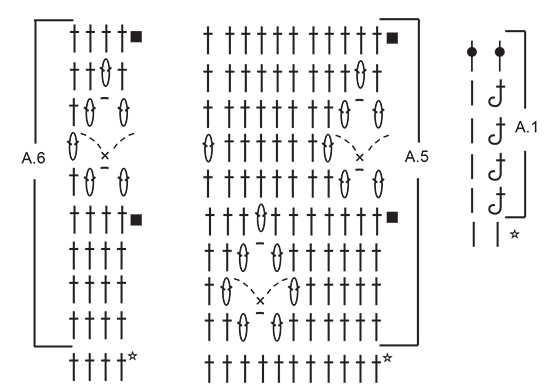
|
||||||||||||||||||||||||||||

|
||||||||||||||||||||||||||||

|
||||||||||||||||||||||||||||
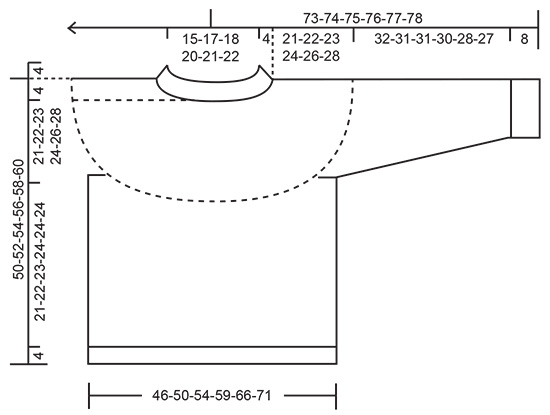
|
||||||||||||||||||||||||||||
|
Have you made this or any other of our designs? Tag your pictures in social media with #dropsdesign so we can see them! Do you need help with this pattern?You'll find tutorial videos, a Comments/Questions area and more by visiting the pattern on garnstudio.com. © 1982-2024 DROPS Design A/S. We reserve all rights. This document, including all its sub-sections, has copyrights. Read more about what you can do with our patterns at the bottom of each pattern on our site. |
||||||||||||||||||||||||||||









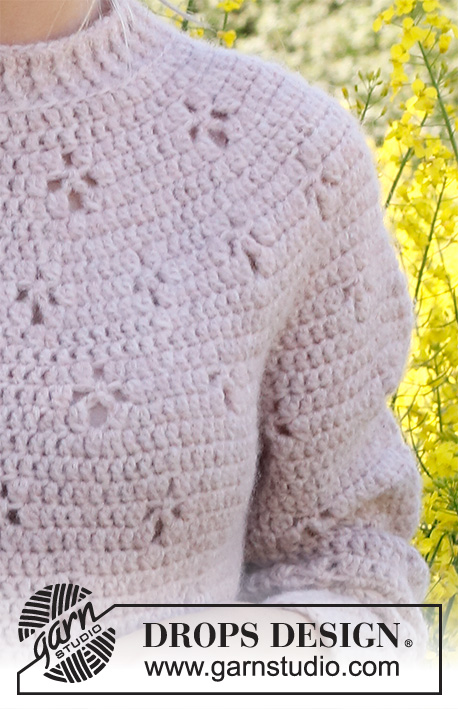


















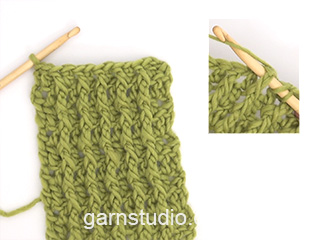




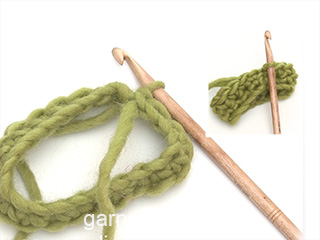




























Comments / Questions (24)
Vielen Dank für die Antwort :). Wie kann ich denn anstatt in Runden in Hin und Rückreihen häkeln? Das muster wird ja in runden gehäkelt?
14.02.2024 - 15:04DROPS Design answered:
Liebe Bianka, die Rückreihen lesen Sie dann links nach rechts (und die Hin-Reihen wie in Runden, rechts nach links). Viel Spaß beim häkeln!
14.02.2024 - 16:32Hallo, Ich habe nun den ersten Arm fertig gehäkelt. Das Problem ist, dass sich eine sichtbare Linie von unter dem Arm nach vorne zeigt. Die Linie ist die Stelle an der die Runde endet bzw. Neu beginnt. Da habe ich auch dem Muster angepasst meine Stäbchen abgenommen. Ist diese Linie normal oder habe ich einen Fehler gemacht?
14.02.2024 - 01:22DROPS Design answered:
Liebe Bianka, sowas passiert oft wenn man in Runden häkelt, um das zu vermeiden dann man abwechslungsweise in Hin- und Rückreihen häkeln (jede Reihe aber mit 1 Kettmasche schließen). Viel Spaß beim häkeln!
14.02.2024 - 08:25Ich bin beim Muster A5 Runde 4 und habe eine Frage wegen den Noppen bzw. Das ersetzen durch Stäbchen. Ich häkel 44 Maschen (4xA5), muss ich nun 1x Noppe, 1x Stäbchen, 1x Noppe, 1x Stäbchen häkeln? Liebe Grüße
04.02.2024 - 00:10DROPS Design answered:
Liebe Bianka, die 4. Reihe A.5 wird einmal genauso wie im Diagram gehäkelt, nach dieser Reihe gehäkelt wird, häkelt man 1 bzw 2 (siehe Größe ) Runden mit nur Stäbchen, so gibt es 1 bzw 2 Runden nur Stäbchen zwischen den Blumen. Viel Spaß beim häkeln!
05.02.2024 - 08:58Ved A2 står der 12 omgange, skal A2 gentages eller forstår jeg det helt forkert ?
30.12.2023 - 05:22DROPS Design answered:
Hej Maibritt, ja du gentager A2 hele vejen rundt om bærestykket :)
03.01.2024 - 08:14Liebes Drops-Team Ich bin in der zweiten Runde des Rumpfteils, Größe M. Habe auch diese mit 9 Stäbchen begonnen. Das erste in dieselbe Masche wie die drei Luftmaschen. Am Ende der Runde habe ich aber anstelle von 8 Maschen 9 die zu häkeln wären. Das Muster stimmt ansonsten. Ist es so, dass am Anfang jeder Runde das erste der 9 Stäbchen in dieselbe Masche wie die drei Luftmaschen gehäkelt wird? Danke
23.09.2023 - 16:15DROPS Design answered:
Liebe Frau Michini, die 3 Luftmaschen am Anfang jeder Runde ersetzen das 1. Stäbchen nicht, die kommer aber extra, so haben Sie in M 72 Stäbchen + 3 Luftmaschen am Anfang der Passe, so 8 Mal die 9 Maschen A.2 + die 3 Lufmaschen am Anfang der Runde - siehe auch HÄKELINFORMATION: am Anfang der Anleitung. Viel Spaß beim häkeln!
25.09.2023 - 08:44Hi bij A5 en A6 heb je een rij met 11 losse en 34 steken overslaan. Als je daarna naar je volgende rij gaat doe je dan nogsteeds 34 overslaan en elke rij 11 losse voor de mouw?
10.07.2023 - 19:53DROPS Design answered:
Dag Sofia,
Nee, de volgende toer zie je de lossen als steken waarin je haakt, dus niet opnieuw lossen haken en steken overslaan.
13.07.2023 - 20:16Har virkat oket på stl S klart. Har 198 st på sista varvet. Nu till problemet när jag ska dela stycket. Jag har 8 maskor över efter att ha virkat 22 m, hoppat över 40 m, virkat 11 lm, virkat 55 m. hoppat över 40 m, 11 lm och virkat 33 m. När jag räknar ihop så blir det 190 m vilket stämmer med min virkning, men enl. mönstret ska det vara 198 m Det fattas även 8 m på fram och bakstycket som ska vara 140 m enl. mönstret, jag har "bara 132 m (22+11+55+11+33=132 m)
06.07.2023 - 13:17DROPS Design answered:
Hej Lillemor, har du hoppat över A.6 ?
07.07.2023 - 10:44Can someone simplify the pattern and diagrams into written rows? I’m having a stroke trying to read this and understand the individual diagrams. I personally don’t think it was translated well at all to American English. Is the entire A1 section one whole row? Why is everything jumbled on one page like that? I love this pattern but I’m getting mad trying to decipher it.
23.05.2023 - 07:56DROPS Design answered:
Dear Victoria, in this lesson we explain how to read crochet diagrams; when working A.1 repeat the 2 stitches the whole round and A.1 will be done when all rows are worked. Happy crocheting!
23.05.2023 - 08:55Hei, jeg jobber med bærestykke nå og er litt forvirret på hva jeg skal gjøre. Jeg har komme til det punktet der man hekler A5 over 22/33 masker, etter det står «A6» vil det si at jeg skal hekle «A6» en gang?
28.03.2023 - 10:14DROPS Design answered:
Hej Elin, ja det stemmer, du hækler A.6 en gang på hver side ifølge opskriften :)
12.04.2023 - 15:05Klopt het dat er dan onder de armen geen patroon is, maar telkens 11 stokjes?
05.02.2023 - 14:17DROPS Design answered:
Dag Kelly,
Dat klopt, je haakt daar de 11 stokjes en je zet het patroon vanaf de pas door op de mouw. Dan 3 cm begin je met het minderen onder de arm.
05.02.2023 - 17:16